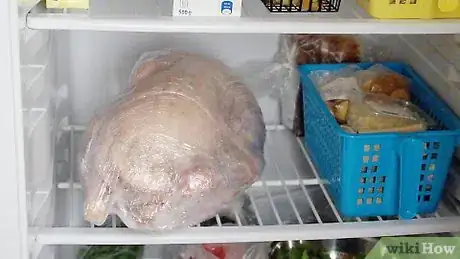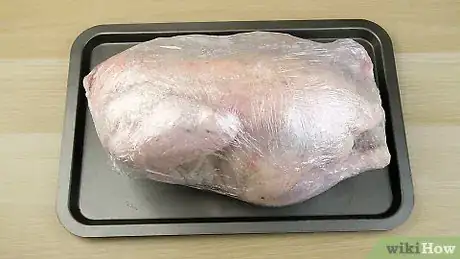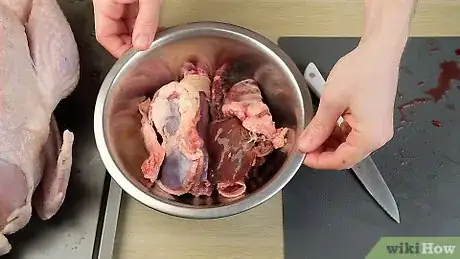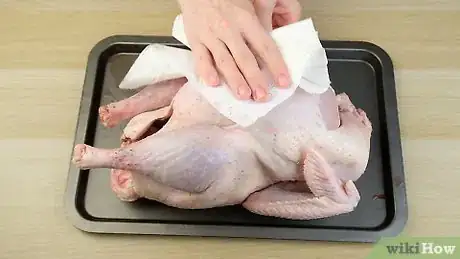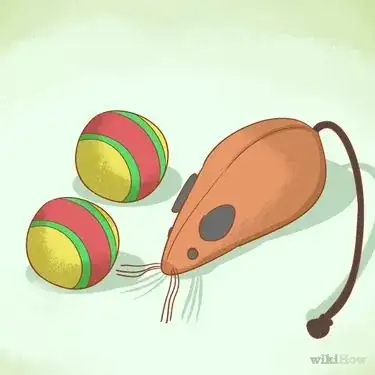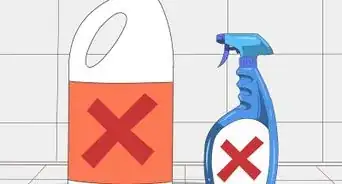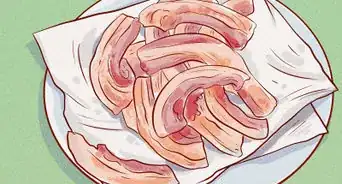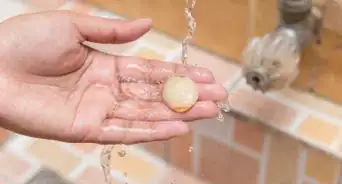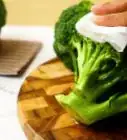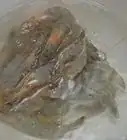This article was co-authored by wikiHow Staff. Our trained team of editors and researchers validate articles for accuracy and comprehensiveness. wikiHow's Content Management Team carefully monitors the work from our editorial staff to ensure that each article is backed by trusted research and meets our high quality standards.
There are 15 references cited in this article, which can be found at the bottom of the page.
The wikiHow Video Team also followed the article's instructions and verified that they work.
This article has been viewed 191,133 times.
Learn more...
Turkey giblets are the edible inside parts of the bird, including the heart, gizzard, and liver. If you bought a whole turkey, it probably still has giblets inside. Start by thawing and unwrapping your turkey. Then, reach into the bird’s front and back cavities to take out the giblets. You can save the giblets for cooking or throw them away. Make sure to clean all surfaces that touched raw meat thoroughly.
Steps
Thawing and Unwrapping the Turkey
-
1Thaw your turkey in the fridge if it’s frozen. It takes about 24 hours to thaw for every 5 pounds (2.3 kg) of turkey. Check if the turkey is completely thawed by inserting a thermometer into the breast at a few different places. The temperature should be between 32 to 40 °F (0 to 4 °C).[1]
- For example, it will take about 3 days for a 15 lb (6.8 kg) turkey to thaw.[2]
- You can also thaw it more quickly in ice water. Put the wrapped turkey in a plastic bag and submerge it in a bucket of cold water. Change the cold water every 30 minutes. It will take about 30 minutes per 1 pound (0.45 kg).[3]
- Don’t leave your turkey to thaw at room temperature.
-
2Place your turkey on a sheet tray or in the sink. Don’t put the turkey in a roasting tray yet, because it will drip a lot of juices as you open it up that you don’t want to cook with. Instead, put the turkey on a sheet tray or in the sink.[4]
- Keep in mind that you will have to clean and sanitize whatever surface comes in contact with raw meat.
Advertisement -
3Remove the wrapping from the turkey. Flip the turkey upside down, and make a slit in the wrapping with a knife. Peel open the wrapping around the turkey to totally remove it. Throw the wrapping directly in the trash since it had contact with raw meat.[5]
- It’s best to open the turkey packaging from the back, so that if you accidentally slit the skin you won’t cut into the breast meat.
- If the turkey legs are hooked together with a plastic piece, you can leave that on during roasting.
Cleaning out the Turkey's Body Cavity
-
1Locate the body cavity between the back legs. The butcher will have cut a large hole between the legs, inside of which you can see the giblets and neck if they are there. The body cavity is fairly large and hard to miss.[6]
- If you don’t immediately see the package of giblets, it might be underneath the neck.
- If there isn’t a body cavity, you will have to gut your turkey, which is a more involved process than simply removing the giblets.
-
2Reach into the body cavity to pull out the giblets. Butchers will usually wrap the giblets in paper or plastic and store them in the front cavity of the turkey. Reach into the body cavity and remove the package.[7]
- Ready-to-cook whole poultry is required to be packaged with giblets in the US. If the giblets might be missing, the poultry processor has to mark the package “giblets may be missing.”[8]
-
3Pull the neck out of the body cavity, if necessary. Even if there are no giblets in the body cavity of your turkey, the neck might still be there. Butchers will either put it in the body cavity or the front cavity. The neck looks like a long rod.[9]
- You can use the turkey neck to make gravy, soup, or smoked turkey neck.[10]
- You can also just throw the turkey neck away.
-
4Check the front cavity for giblets as well. Sometimes, the butcher will store the package of giblets in the front cavity instead of the body cavity. Look at the top of your turkey, between the wings. There will be a hole where the neck once was. Pull open the hole so you can look inside. If there’s a package of giblets there, pull it out.[11]
- If the package claims there are giblets in the turkey, but you don’t see them, check again.
-
5Set aside the giblets for cooking or toss them. You can use giblets in gravy, stock, or side dishes. Some people like to cook the turkey with the giblets directly underneath, to give a richer flavor to the gravy. However, if you don’t want to bother, you can just toss the giblets.[12]
- If you throw out the giblets, make sure to take out the trash within a few hours so the smell doesn’t get bad.
-
6Pat the turkey dry with paper towels. Take a handful of paper towels, and pat dry the entire outside of the turkey. Turkeys roast much better when they are dry. Remember to throw out the paper towels immediately.[13]
- It’s better to pat rather than rub so that the paper towels don’t shred onto the turkey.
-
7Wash your hands and work surfaces with hot soapy water. Wash your hands with warm water and soap, scrubbing for at least 20 seconds before rinsing them with running water. Also, scrub your counters, utensils, cutting boards, sink, trays, and anything else that touched the raw turkey with warm soapy water.[14]
- Do this is as soon as you’re done cleaning out the turkey, because bacteria from raw meat is dangerous.
- You can also sanitize the surfaces with bleach and water to be extra safe. Make a diluted mixture of bleach and water, with a ratio of 1 tablespoon (15 mL) bleach to 1 gallon (3.8 L) water. Let the bleach mixture sit on the counter for 2 minutes and then wipe it off.[15]
-
8Cook your turkey with your favorite method. You can roast, smoke, grill, or deep fry your turkey. You can get fancy with the spices or even wrap your turkey in bacon.[16]
- Don’t leave your turkey sitting around – if you’re not going to cook it immediately, put it back in the fridge.
Our Most Loved Articles & Quizzes
Things You’ll Need
- Turkey
- Knife
- Tray
- Paper Towels
- Bleach
References
- ↑ https://www.epicurious.com/expert-advice/how-to-thaw-a-turkey-for-thanksgiving-dinner-tips-article
- ↑ https://www.epicurious.com/expert-advice/how-to-prep-a-turkey-for-thanksgiving-article
- ↑ http://dish.allrecipes.com/how-to-safely-thaw-frozen-turkey/
- ↑ https://youtu.be/--d5g-Ic6_U?t=54
- ↑ https://youtu.be/--d5g-Ic6_U?t=38
- ↑ https://youtu.be/LCEQmnjoKhY?t=69
- ↑ https://www.myfearlesskitchen.com/whats-that-stuff-inside-my-turkey/
- ↑ https://www.fsis.usda.gov/wps/wcm/connect/8c532492-e9a6-43c7-abff-d5a00cb3f642/Giblets_and_Food_Safety.pdf?MOD=AJPERES
- ↑ https://youtu.be/LCEQmnjoKhY?t=72
- ↑ https://momsdish.com/recipe/535/turkey-necks-recipe
- ↑ https://www.myfearlesskitchen.com/whats-that-stuff-inside-my-turkey/
- ↑ https://www.epicurious.com/expert-advice/how-to-cook-with-turkey-giblets-article
- ↑ https://youtu.be/--d5g-Ic6_U?t=82
- ↑ https://www.recipetips.com/kitchen-tips/t--431/cleaning-turkey.asp
- ↑ https://www.recipetips.com/kitchen-tips/t--431/cleaning-turkey.asp
- ↑ https://www.thedailymeal.com/best-recipes/25-ways-cook-turkey
- ↑ https://www.fsis.usda.gov/wps/wcm/connect/8c532492-e9a6-43c7-abff-d5a00cb3f642/Giblets_and_Food_Safety.pdf?MOD=AJPERES
- ↑ https://youtu.be/o9OWjWIz-gc?t=39
